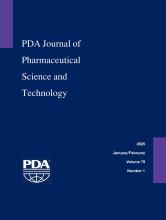Abstract
Abstract: Particles in drug products are not good and are therefore regulated. These particles can come from the very beginning of the manufacturing process, from the raw materials. To prevent particles, it is important to understand what they are and where they come from so the raw material quality, processing, and shipping can be improved. Thus, it is important to correctly identify particles seen in raw materials. Raw materials need to be of a certain quality with respect to physical and chemical composition, and need to have no contaminants in the form of particles which could contaminate the product or indicate the raw materials are not pure enough to make a good quality product. Particles are often seen when handling raw materials due to color, size, or shape characteristics different from those in the raw materials. Particles may appear to the eye to be very different things than they actually are, so microscope, chemical, and elemental analyses are required for accuracy in proper identification. This paper shows how using three different spectroscopy tools correctly and together can be used to identify particles from extrinsic, intrinsic, and inherent particles. Sources of materials can be humans and the environment (extrinsic), from within the process (intrinsic), and part of the formulation (inherent). Microscope versions of Raman spectroscopy, laser-induced breakdown spectroscopy (LIBS), and IR spectroscopy are excellent tools for identifying particles because they are fast and accurate techniques needing minimal sample preparation that can provide chemical composition as well as images that can be used for identification. The micro analysis capabilities allow for easy analysis of different portions of samples so multiple components can be identified and sample preparation can be reduced. Using just one of these techniques may not be sufficient to give adequate identification results so that the source of contamination can be adequately identified. The complementarity of the techniques provides the advantage of identifying various chemical and molecular components, as well as elemental and image analyses. Correct interpretation of the results from these techniques is also very important.
- Received July 28, 2017.
- Accepted April 16, 2018.
- Copyright © 2018, Parenteral Drug Association
PDA members receive access to all articles published in the current year and previous volume year. Institutional subscribers received access to all content. Log in below to receive access to this article if you are either of these.
If you are neither or you are a PDA member trying to access an article outside of your membership license, then you must purchase access to this article (below). If you do not have a username or password for JPST, you will be required to create an account prior to purchasing.
Full issue PDFs are for PDA members only.
Note to pda.org users
The PDA and PDA bookstore websites (www.pda.org and www.pda.org/bookstore) are separate websites from the PDA JPST website. When you first join PDA, your initial UserID and Password are sent to HighWirePress to create your PDA JPST account. Subsequent UserrID and Password changes required at the PDA websites will not pass on to PDA JPST and vice versa. If you forget your PDA JPST UserID and/or Password, you can request help to retrieve UserID and reset Password below.






